Search has changed forever. In 2025, zero-click searches – queries that deliver the answer directly on Google’s results page – now dominate. According to Similarweb data, more than 80% of all searches end without a single click, redefining what SEO success means.
This report dives deep into verified zero click search statistics in 2025, the rise of AI Overviews, and how brands can adapt through Zero-Click SEO and Answer Engine Optimization (AEO) to thrive in this clickless era.
What Is a Zero-Click Search?
A zero-click search happens when users get the answer they need directly on the Search Engine Results Page (SERP), without visiting any external site.
For example:
- Asking “when is the next leap year” provides the year 2028 instantly – no click required.
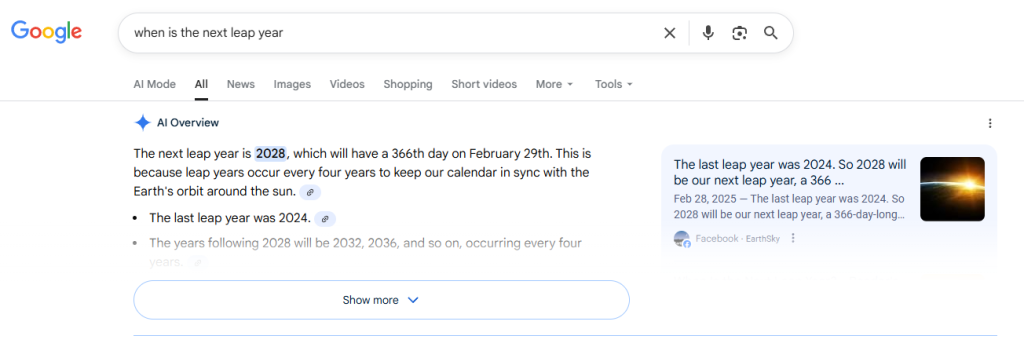
- Typing “15 USD to GBP” displays Google’s live currency converter – again, zero clicks.
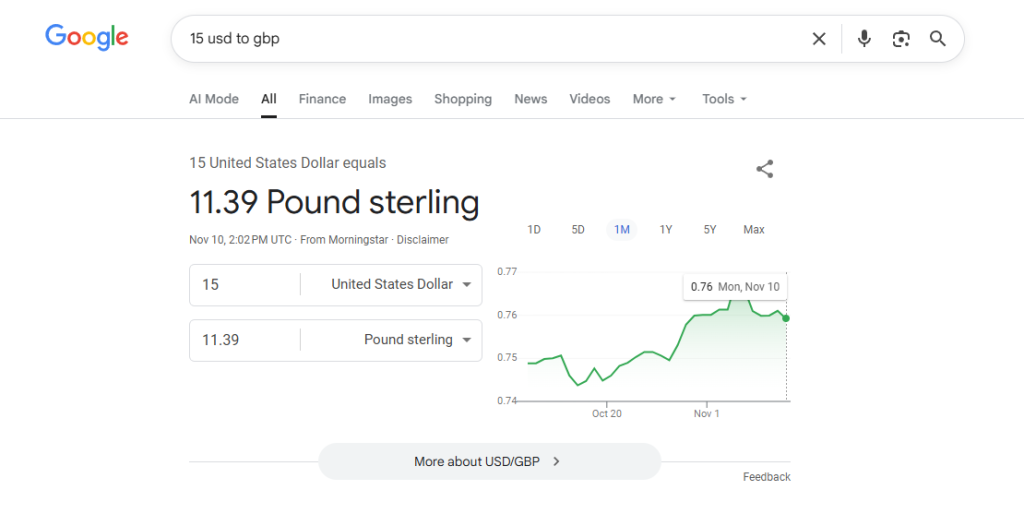
These interactions, powered by Google’s AI Overviews, Featured Snippets, Knowledge Panels, and Direct Answer Boxes, now satisfy user intent before a visit ever occurs.
In other words:
“The search results page is no longer a gateway—it’s the destination.” — Limor Barenholtz, Similarweb (May 2025)
Zero-Click Search Statistics 2025: Complete Analysis & Historical Evolution
The rise of zero-click searches represents the most profound shift in search behavior since Google introduced featured snippets. As AI overviews, voice assistants, and instant-answer modules replace traditional links, understanding how this transition unfolded and what it means for visibility, has become central to every SEO and content strategy in 2025. This growing body of zero click search statistics makes it clear how rapidly user behavior has moved away from outbound clicks.
| Year | Global Zero-Click Rate | Primary Driver | Notable Feature Impact |
| 2020 | 64.8% | Featured Snippets, Knowledge Panels | Defined start of answer-engine behavior; most queries still drove outbound clicks |
| 2021 | ~66% | Rich Snippets, Instant Answers | Emergence of “calculator” / unit-conversion boxes; rise of “People Also Ask” |
| 2022 | 68% | Local Packs, Mobile SERPs | Majority of navigation and business look-ups resolved within Google Maps / Business Profile |
| 2023 | 70% | Voice Search, Knowledge Graph Expansion | Voice-assistant responses replace fact queries; definitions and bios go zero-click |
| 2024 | 75% | Launch of AI Overviews (AIO) | Early AIO tests show ~40% CTR decline for informational keywords |
| 2025 | 80–85% | AIO, Gemini, ChatGPT Search, Perplexity AI | Multi-modal answers dominate; factual, news, and local searches increasingly resolved in-SERP |
Primary Data Sources: SparkToro (2020, 2021), Similarweb (2025), Inner Spark Web Report (2022), BrightEdge + Semrush (2023), Ars Technica + Search Engine Land (2024), MarTech + Single Grain (2025).
Key Insight: Searches triggering AI Overviews now show an average zero-click rate of 83%, while traditional queries (without AIO) average around 60%.
In other words, 8 out of 10 users now get their answer directly inside the search interface.
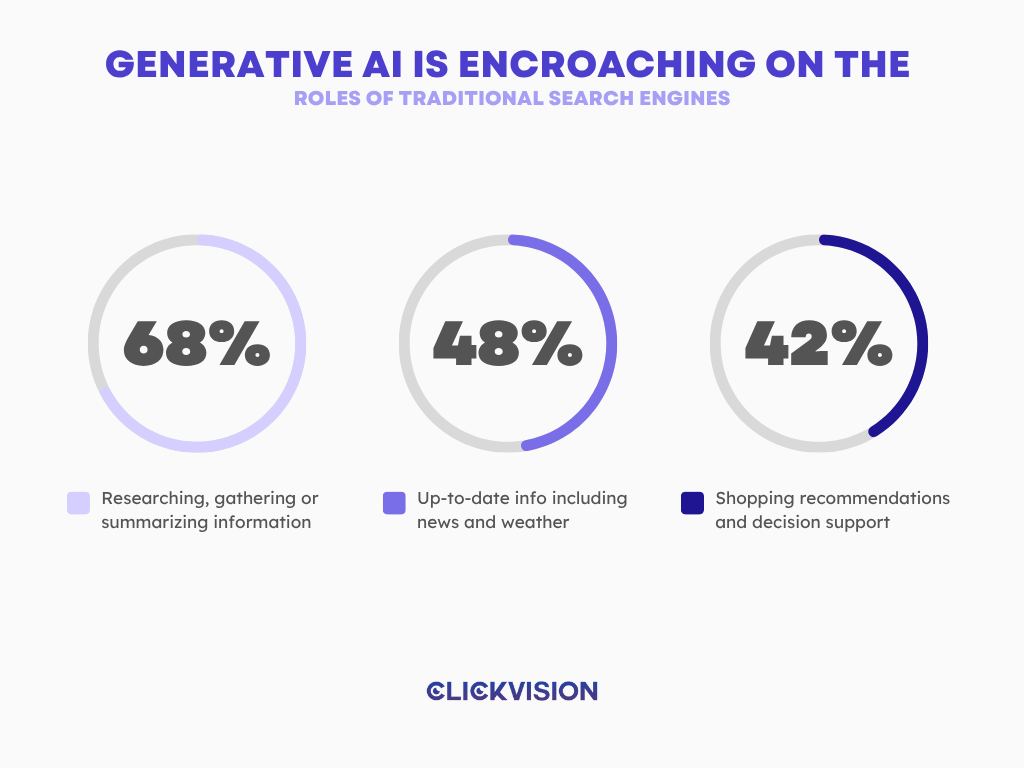
What the Data Really Shows (2020–2025)
The numbers in the timeline for Zero-Click Search Statistics 2025 reflect more than growth — they reveal a structural shift in how search engines handle user intent. From 2020’s feature-based snippets to 2025’s AI-driven summaries, each year represents a measurable reduction in the “open web” share of traffic.
2020–2021: The Foundation of Zero-Click Behavior
Research from Similarweb showed that by mid-2020, 64.8% of Google searches ended without any click-through, as users increasingly found answers in knowledge panels, definitions, and instant results.
By 2021, SparkToro’s trend report noted a rise to roughly 66%, driven by expanded “People Also Ask” boxes and the first generation of calculator and conversion modules. This era established Google’s long-term objective: satisfy the query inside the SERP rather than directing traffic outward.
2022–2023: The Mobile and Voice Acceleration Phase
In 2022, the shift became device-driven. Mobile search accounted for more than 63% of total Google queries, and local-intent searches (e.g., “near me”) produced up to 78% zero-click outcomes, according to Similarweb’s mobile trend data. Google Maps, Local Packs, and Business Profiles became de-facto micro-sites.
By 2023, voice search adoption surpassed 50% among U.S. adults (Pew Research, 2023), while BrightEdge documented a 25–30% drop in organic clicks for informational queries as Knowledge Graph and voice-assistant results replaced simple fact lookups.
2024: AI Overviews Reshape CTR Models
When Google’s AI Overviews (AIO) launched widely in 2024, the impact on click-through rates (CTR) was immediate. Ars Technica reported ~40% average CTR decline on informational and research-intent keywords once AIO summaries appeared.
At the same time, Word Steam’s zero-click index climbed to 75%, with news and publisher traffic seeing the steepest losses. This was the year when “position 1” stopped being synonymous with “visibility.”
2025: The AI Consolidation Year
By 2025, Semrush recorded AI Overviews appearing on 13.14% of all U.S. desktop queries, double the January figure. BrightEdge confirmed that longer, conversational or question-style queries (8+ words) trigger Google AI Overviews far more often than shorter queries, making long-tail, question-based content increasingly important for SEO.
Meanwhile, Similarweb’s aggregated data shows that for AIO-triggered results, the median zero-click rate reached 80%, averaging around 83%. Traditional queries without AIOs still hovered near 60%. This aligns with broader zero click search statistics showing that AI-driven SERPs now resolve most informational intent without users ever needing to leave the page.
Adding to that, platforms such as Gemini, ChatGPT Search, and Perplexity AI now satisfy informational intent conversationally, compounding Google’s trend. Collectively, these developments point toward a web where 80–85% of all user interactions remain within a closed search ecosystem.

The Real Impact of Zero-Click Search Statistics 2025
The implications go far beyond lost traffic metrics.
- Attribution becomes opaque: With fewer outbound visits, analytics platforms capture less behavioral data, complicating ROI models.
- Brand exposure shifts to inclusion: Visibility now depends on how frequently your content or entity is referenced inside AI summaries.
- E-E-A-T signals drive algorithmic trust: Content freshness, factual consistency, and structured data determine whether your information is chosen for display.
- Voice, local, and multimodal queries expand the gap: Non-visual interfaces (smart speakers, car dashboards, wearables) produce zero-screen zero-click behavior, accelerating the trend.
Zero-Click Impact Metrics
| Data Point | Stat / Source | Interpretation |
| Open-web clicks per 1 000 searches (US) | 360/1000 – SparkToro 2024 | Only 36% of searches generate any external click. |
| Zero-click rate for news queries | 69% (May 2025) – TechCrunch | Publisher visibility reduced by ~13 pp in one year. |
| AI Overviews prevalence | 13.14% of queries (Mar 2025) -Semrush | Indicates aggressive AIO rollout for complex queries. |
| CTR drop on informational queries | ≈ 40% decline -Ars Technica 2024 | Confirms reduced engagement even for high-rank pages. |
| Zero-click share on mobile local searches | 78% -Similarweb 2023 | Most interactions occur through call or map actions. |
The data confirms that zero-click is not a temporary anomaly – it’s the new baseline.
Marketers who treat AIOs, snippets, and local packs as distribution layers rather than threats are already gaining visibility. Winning in 2025 means optimizing for answer inclusion, entity clarity, and structured credibility, not just keyword rankings.
How Americans and Europeans Stopped Clicking
The global search landscape has reached a tipping point. Data from SparkToro, Datos, and Similarweb shows that the once-reliable flow of traffic from Google’s search results to external websites has dramatically weakened. Across regions and devices, more searches now end on Google itself – without a single click to another domain.
The U.S. Shift: Google’s Walled Garden Expands
In the United States, the trend toward zero-click behavior accelerated sharply through 2024. Roughly 41.5% of all searches generated at least one click, but a deeper look reveals how much of that activity now stays within Google’s ecosystem. Of all clicks made, 70.5% were directed to organic listings, while 28.5% were captured by Google-owned properties such as YouTube, Maps, and Images. A mere 1% led to paid ads, reflecting the limited share of traditional advertising engagement.
The more striking figure, however, is what doesn’t happen. 58.5% of searches ended with no click at all— a complete session without user interaction beyond the results page. This represents a fundamental behavioral change: users are finding answers directly through AI-generated summaries, snippets, and knowledge panels rather than visiting external websites. In practical terms, for every 1,000 Google searches in the U.S., only about 360 clicks make it to the open web. The remaining majority either find answers instantly or refine their query within Google’s interface.
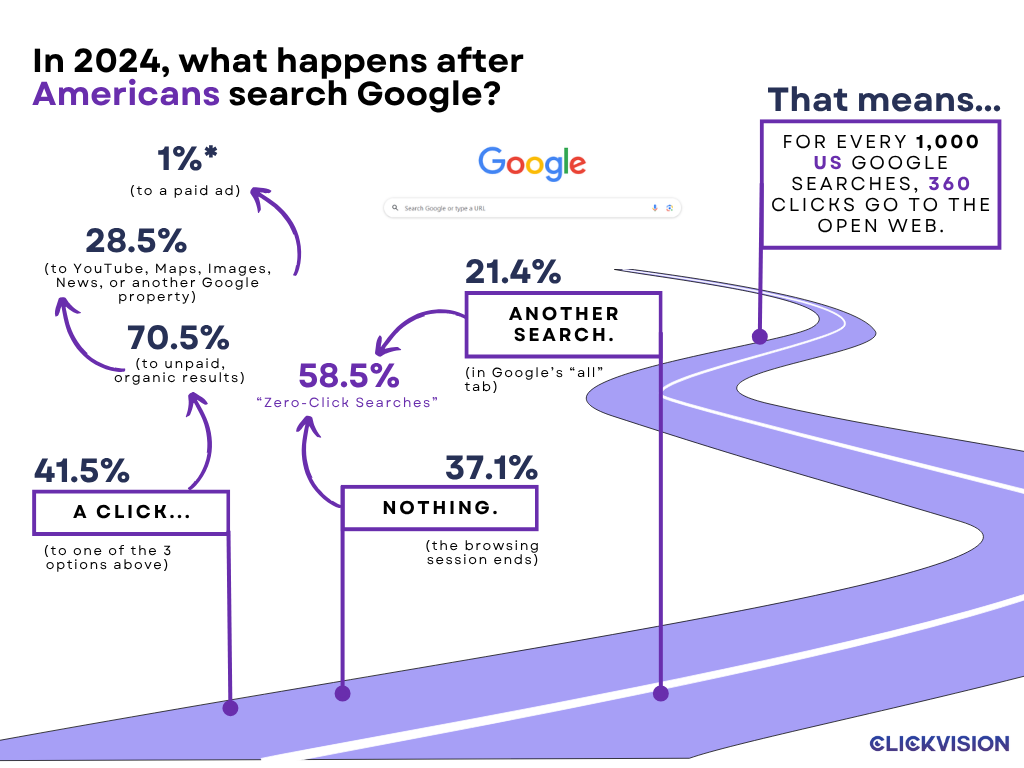
Europe: Slightly More Open, But Still Zero-Click Dominant
European users exhibit a similar, though marginally less severe, pattern. In 2024, 40.3% of Google searches resulted in at least one click, and 74.6% of those clicks led to organic results. Meanwhile, 24% of interactions went to Google-owned products, and 1.4% to paid ads. Despite these regional nuances, the overall picture remains nearly identical: 59.7% of searches across Europe end without a single external click.
For every 1,000 searches performed in the EU, roughly 374 clicks reach independent websites, compared to 360 in the U.S. Analysts suggest that the difference may be attributed to the Digital Markets Act (DMA), which pressures Google to present a fairer mix of external sources within search results. However, even with regulatory influence, the open web’s share of engagement continues to erode year over year.
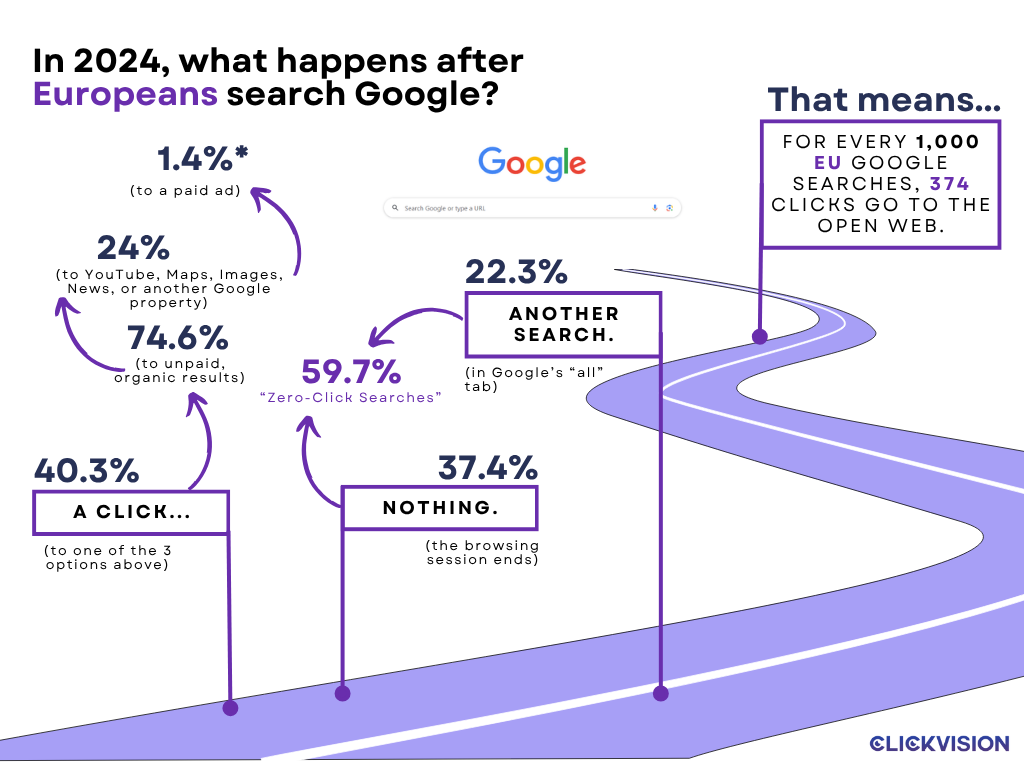
Mobile Dominance and AI Integration
By early 2025, zero-click searches had moved from trend to standard behavior. According to the SEO Bazooka 2025 report, around 60% of all global searches now result in no external click. Mobile searches are driving this transformation: on phones, 77% of queries end without visiting another website, compared to 46.5% on desktop, as reported by Up & Social (2025). With AI summaries, widgets, and voice results instantly answering queries, mobile users simply have fewer reasons to leave the search results page.
Year-over-Year Changes: 2024 → 2025
Analysis from Search Engine Land highlights how the pace of zero-click adoption has intensified. Between March 2024 and March 2025, the U.S. saw its zero-click rate rise from 24.4% to 27.2%, while the EU and UK increased from 23.6% to 26.1%. Over the same span, organic click-through rates (CTR) fell to 40.3% in the U.S. and 43.5% in the EU/UK, as more users interacted with AI-generated content directly in the SERP. Clicks to Google-owned properties grew steadily to 14.3% in the U.S. and 12.6% in the EU/UK, indicating Google’s growing dominance over user pathways.
Why Zero-Click Searches Are Rising
1. AI Overviews Take Over SERPs
Google’s AI Overviews (AIO) now appear on roughly 13% of all U.S. desktop queries (Semrush, March 2025). They summarize insights from multiple trusted sources—Healthline, Forbes, Wikipedia, etc.—into conversational, citation-based responses.

Examples:
- Searching “how much protein do I need per day” returns a full AI Overview citing multiple health publishers with a visual breakdown—no click required.
- Typing “how to clean solar panels” produces a step-by-step guide inside the Overview, blending content from The Spruce and Home Depot.
- Asking “best AI tools for marketers 2025” shows a curated list compiled from HubSpot, ClickUp, and MarTech—users never leave Google.
Stat Insight: BrightEdge’s 2025 study found CTRs drop by 40% on queries that trigger AIOs versus traditional SERPs.
→ Users now complete research, comparisons, and decisions within the search results – websites merely serve as cited sources.
2. Direct Interaction Tools
Built-in calculators, time converters, and weather widgets have become everyday examples of zero-click design. Similarweb’s analysis shows that search categories such as finance, weather, and conversions have among the highest zero-click rates (up to 100%).
These tools let users perform actions instantly – removing the need to visit an external website.
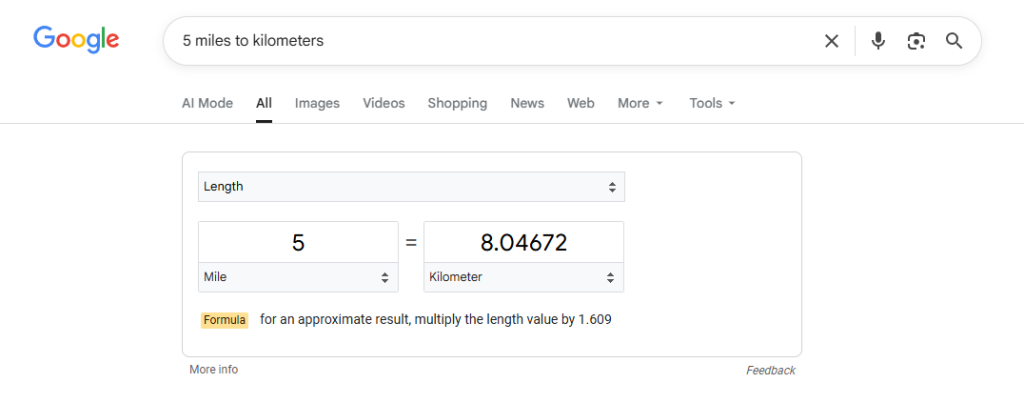
Examples:
- Searching “100 USD to EUR” displays a live currency converter with real-time exchange rates.
- Typing “5 miles to kilometers” activates Google’s inline conversion tool.
- Typing “time in Tokyo” shows an interactive clock with local time zones.
According to SparkToro, more than 20% of all daily searches globally contain paid ads, and nearly all of them are resolved via these in-SERP tools—cementing zero-click as the default for factual or utility-driven intent.
3. Knowledge Panels & Instant Facts
Google’s Knowledge Graph powers panels that instantly deliver structured entity data – covering everything from people and brands to products and locations. These panels now resolve a majority of fact-based searches.
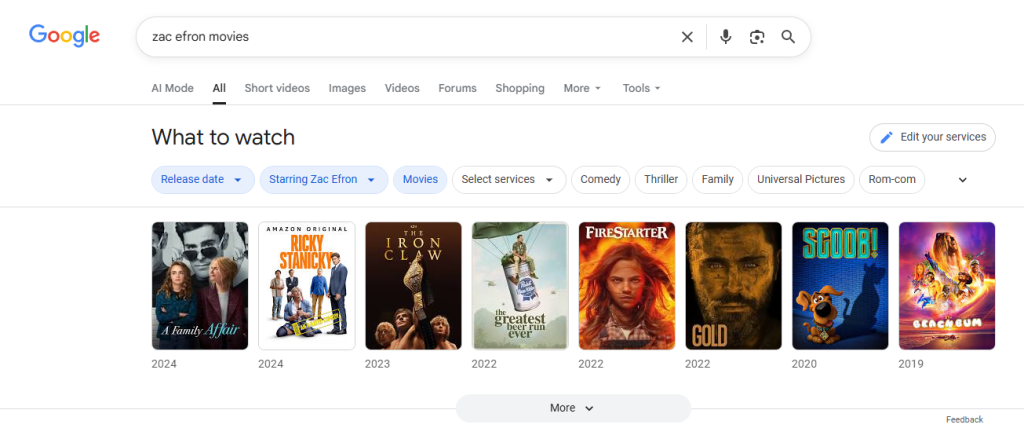
Examples:
- Query “CEO of Microsoft” instantly displays Satya Nadella with image, title, and company bio.
- Searching “population of Brazil” returns the latest data from the World Bank alongside a visual growth chart.
- Typing “NVIDIA revenue 2024” shows a financial snapshot with earnings data from Google Finance.
- Query “Zac Efron movies” reveals a carousel of his filmography without visiting IMDb.
The MarTech 2025 Visibility Report highlights that entity-based results now occupy over 25% of first-page real estate. This means content structured around schema, Wikidata alignment, and E-E-A-T (Experience, Expertise, Authoritativeness, Trust) signals is more likely to surface in these instant panels.
Visibility Insight: appearing within a Knowledge Panel now generates more brand impressions than traditional top-10 rankings.
4. People Also Ask (PAA) Expansion
Google’s People Also Ask has evolved into an interactive micro-FAQ engine. It now populates dynamically based on query context and user behavior, expanding to show related questions with inline answers.

Examples:
- Searching “how to write a cover letter” expands to reveal “What should you avoid in a cover letter?” and “How long should it be?”—each sourced from top-ranking HR blogs.
- The query “causes of climate change” displays nested follow-ups like “How much does CO₂ contribute?” and “Can climate change be reversed?”
- Typing “best time to water plants” surfaces multiple question boxes, each showing content from gardening authorities like The Spruce and Gardeners’ World.
According to Briskon (2025), PAA boxes appear in about 75% of mobile and desktop searches ( 92% of SERPs for informational searches), absorbing an estimated 15–20% of total search interactions. Users typically expand multiple questions per query, fulfilling their curiosity without ever clicking away.
Content Strategy Tip: Optimizing for PAA visibility – using question-based headings, FAQ schema, and concise answers – remains one of the most effective zero-click SEO tactics in 2025.
How SERP Features Drive the Rise of Zero-Click Searches (2025 Data)
| SERP Feature | Description | Zero-Click Impact (Average) | Example |
| AI Overviews (AIO) | AI-generated summaries replacing article content | 🔺 +83% | “What are zero-drop shoes?” |
| Featured Snippets | Concise pulled answers with a blue link | ~60% | “How to write a cover letter” |
| Direct Answer Box | Factual response (time, math, conversions) | 🔺 100% | “Grams to pounds” |
| Knowledge Panel | Entity-based profile pulled from structured data | 🔺 90% | “Clint Eastwood” |
| People Also Ask (PAA) | Expandable FAQ-style dropdowns | 70–80% | “What is zero click SEO?” |
| Local Pack | Maps and business listings | 70–85% | “Pool fence installer near me” |
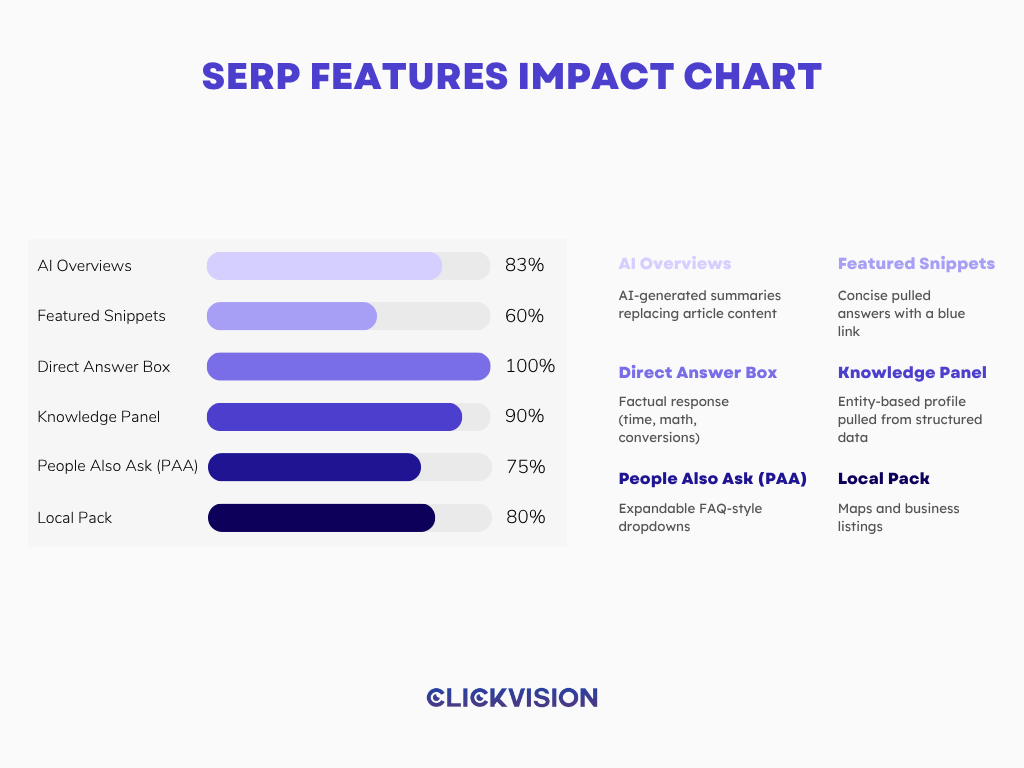
Measuring Visibility in the Zero-Click Era (AEO Metrics)
| Metric | Description | Measures |
| Answer Inclusion Rate (AIR) | How often your content appears inside AI-generated answers | Algorithmic trust & citation frequency |
| Entity Presence Index (EPI) | Frequency of brand/entity recognition in AI & search | Brand knowledge graph strength |
| Source Authority Score (SAS) | Quality, structure, and freshness of your content | AI-read trustworthiness |
| AI Citation Frequency (AICF) | Number of times your brand is quoted in AI results | Influence across generative platforms |
These metrics now define success in the zero-click era.
They measure visibility before the click – not after.
How to Use Zero-Click SEO in 2025
1. Identify Zero-Click Keywords
Use Similarweb, Ahrefs, or Semrush to find terms with high zero-click probability (like “meaning,” “convert,” “time in,” “definition”).
2. Structure Content for Extraction
- Write answers in clear 40–60 word paragraphs.
- Use H2 and H3 headings that mirror user queries.
- Add FAQ schema and HowTo markup.
3. Optimize for AI Overviews
- Depth: Add context, not fluff.
- Trust: Cite credible data sources (e.g., Pew, Statista).
- Structure: Use bullet points, tables, and key takeaways.
4. Refresh and Republish Regularly
AI engines favor freshness and recency. Update content quarterly to maintain inclusion in AI Overviews.
5. Track Visibility, Not Just Traffic
Monitor AI mentions, schema validation, and branded search growth via tools like Google Search Console + Similarweb Visibility Reports.
Why This Matters for Marketers
As the latest zero click search statistics in 2025 confirm, for marketers, the zero-click era has rewritten the rules of visibility. Traditional metrics like organic clicks and website sessions no longer tell the full story of brand performance. In a world where Google’s AI Overviews, knowledge panels, and featured snippets answer questions before a user ever leaves the results page, visibility now lives inside the search experience – not beyond it.
A brand can dominate the conversation even without earning the click. When your content appears in an AI-generated summary, your expertise is being read, referenced, and trusted within the SERP itself. That presence builds authority in ways that traffic data alone cannot capture.
This evolution marks the rise of Answer Engine Optimization (AEO) – the new bridge between traditional SEO and AI-driven discovery. AEO focuses not just on ranking for queries, but on being cited, summarized, and referenced by the engines that increasingly deliver answers, not links.
In this environment, marketers must measure success through visibility, trust, and inclusion within AI-generated content. It’s no longer about where users go – it’s about what they see, who they trust, and which voices shape their understanding before they ever click.
As MarTech (2025) summarized it best:
“The next era of marketing will favor those who measure what matters most: being known, being credible, and being chosen.”
Conclusion
Zero-click searches aren’t killing SEO – they’re redefining it. The data behind zero click search statistics in2025 shows that visibility now depends less on where you rank and more on how your content is surfaced within AI-driven summaries, voice results, and generative SERPs.
The brands that adapt fastest to this clickless ecosystem will dominate across AI search, voice, and conversational engines.
To win in 2025 and beyond, focus on visibility metrics, not just clicks. Build content that’s designed for extraction and citation. Measure trust, authority, and entity recognition—these are the new signals of success in a zero-click world.
Because in 2025, visibility isn’t about who ranks highest – it’s about who’s cited most often.
Success = being the answer, not hosting the answer.
